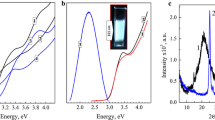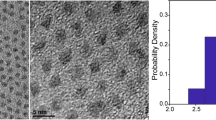Abstract
We have studied the effect of disodium EDTA concentration on the size and zeta potential of CdS nanoparticles in a stable aqueous solution. Measurement results demonstrate that the colloidal solution remains stable at initial Cd2+ and S2− concentrations of 8 mM and initial EDTA concentrations in the range 3.2 to 16 mM. The reactant mixing sequence is shown to influence the ionic state of EDTA in solution, which in turn influences the stabilization mechanism of the CdS nanoparticles. At pH 3, we observe the formation of protonated chelates such as [CdHY]−, which may form a [-S-Cd-EDTA] ternary complex with the surface of a nanoparticle, thereby ensuring stability of the colloidal solution at a twofold excess of EDTA. Analysis of the nanoparticle size distribution evaluated by dynamic light scattering measurements indicates that the minimum hydrodynamic diameter of the nanoparticles is 10 ± 3 nm. The corresponding zeta potential is about −20 mV.
Similar content being viewed by others
References
Alivisatos, A.P., Semiconductor clusters, nanocrystals, and quantum dots, Science, 1996, vol. 271, pp. 933–937.
Ma, Q., Wang, C., and Su, X., Synthesis and application of quantum dot-tagged fluorescent microbeads, Nanosci. Nanotechnol., 2005, vol. 8, no. 3, pp. 1138–1149.
Zhou, M., Nakatani, E., Gronenberg, L.S., et al., Peptide-labeled quantum dots for imaging GPCRs in whole cells and as single molecules, Bioconjugate Chem., 2007, vol. 18, no. 2, pp. 323–332.
Hullavarad, N.V., Hullavarad, S.S., and Karulkar, P.C., Cadmium sulphide (CdS) nanotechnology: synthesis and applications, J. Nanosci. Nanotechnol., 2008, vol. 8, pp. 3272–3299.
Munirah Khan, M.S., Aziz, A., Rahman, S.A., and Khan, Z.R., Spectroscopic studies of sol-gel grown CdS nanocrystalline thin films for optoelectronic devices, Mater. Sci. Semicond. Process., 2013, vol. 16, pp. 1894–1898.
Boey, H.T., Tan, W.L., Abu Bakar, N.H.H., et al., Formation and morphology of colloidal chitosan-stabilized copper sulfides, J. Phys. Sci., 2007, vol. 18, no. 1, pp. 87–101.
Wageha, S. and Badrb, M.H., Cd1 − x ZnxS nanoparticles stabilized by a bifunctional organic molecule, Phys. E (Amsterdam, Neth.), 2008, vol. 40, pp. 2810–2813.
Bryan, J.D. and Gamelin, D.R., Doped semiconductor nanocrystals: synthesis, characterization, physical properties and applications, J. Prog. Inorg. Chem., 2005, vol. 54, pp. 47–126.
Oleinikov, V.A., Sukhanova, A.V., and Nabiev, I.R., Fluorescent semiconductor nanocrystals in biology and medicine, Ross. Nanotekhnol., 2007, vol. 2, nos. 1–2, pp. 160–173.
Rempel, A.A., Hybrid nanoparticles based on sulfides, oxides, and carbides, Izv. Akad. Nauk, Ser. Khim., 2013, vol. 62, no. 4, pp. 857–869.
Kozhevnikova, N.S., Vorokh, A.S., and Rempel, A.A., Preparation of stable colloidal solution of cadmium sulfide CdS using ethylenediaminetetraacetic acid, Russ. J. Gen. Chem., 2010, vol. 80, no. 3, pp. 391–394.
Kozhevnikova, N.S., Demin, A.M., Krasnov, V.P., and Rempel, A.A., The use of 3-mercaptopropyltrimethoxysilane for stabilization of luminescent cadmium sulfide nanoparticles, Dokl. Chem., 2013, vol. 452, no. 1, pp. 215–219.
Frolov, Yu.G., Kursk kolloidnoi khimii. Poverkhnostnye yavleniya i dispersnye sistemy (A Course of Colloid Chemistry: Surface Phenomena and Disperse Systems), Moscow: Khimiya, 1988.
Evstratova, K.I., Kupina, N.I., and Malakhova, E.E., Fizicheskaya i kolloidnaya khimii (Physical and Colloid Chemistry), Moscow: Vysshaya Shkola, 1990.
Dyatlova, N.M., Temkina, V.Ya., and Popov, K.I., Kompleksony i kompleksonaty metallov (Chelating Agents and Metal Chelates), Moscow: Khimiya, 1988.
Dahneke, B.E., Measurement of Suspended Particles by Quasi-Elastic Light Scattering, New York: Wiley, 1983.
Pecora, R., Dynamic Light Scattering: Applications of Photon Correlation Spectroscopy, New York: Springer Plenum, 1985.
Kaszuba, M., McKnight, D., Connah, M.T., et al., Measuring sub nanometre sizes using dynamic light scattering, J. Nanopart. Res., 2008, vol. 10, pp. 823–829.
Tscharnuter, W., Photon correlation spectroscopy in particle sizing, in Encyclopedia of Analytical Chemistry, New York: McGraw Hill, 2000, pp. 5469–5480.
Hunter, R.J., Zeta Potential in Colloid Science: Principles and Applications, London: Academic, 1988.
Rempel, A.A., Kozhevnikova, N.S., and Rempel, S.V., Structure of a micelle of cadmium sulfide nanoparticles in aqueous solutions, Izv. Akad. Nauk, Ser. Khim., 2013, no. 2, pp. 400–404.
Shchukin, E.D., Pertsov, A.V., and Amelina, E.A., Kolloidnaya khimiya (Colloid Chemistry), Moscow: Vysshaya Shkola, 2004.
Umland, F., Janssen, A., Thierig, D., and Wunsch, G., Theorie und praktische Anwendung von Komplexbildnern, Frankfurt am Main: Akademische Verlagsgesellschaft, 1971.
Terent’ev, R.A., Chebotarev, V.K., Il’ina, E.G., et al., Some aspects of the reactivity of the ethylenediaminetetraacetic acid (EDTA) disodium salt, Izv. Altaisk. Gos. Univ. Khim., 2011, no. 3-1 (71), pp. 142–146.
Petrukhin, O.M., Analiticheskaya khimiya. Khimicheskie metody analiza (Analytical Chemistry: Chemical Analysis Methods), Moscow: Khimiya, 1993.
Přibil, R., Analytical Applications of EDTA and Related Compounds, Oxford: Pergamon, 1972.
Rabinovich, Yu.V., Kropacheva, T.N., Didik, M.V., and Kornev, V.I., Effect of amino polycarboxylates on copper(II) ion sorption by aluminum oxide, Vestn. Udmurtsk. Univ. Fiz. Khim., 2013, no. 3, pp. 19–27.
Author information
Authors and Affiliations
Corresponding author
Additional information
Original Russian Text © Yu.V. Kuznetsova, A.A. Rempel, 2015, published in Neorganicheskie Materialy, 2015, Vol. 51, No. 3, pp. 262–266.
Rights and permissions
About this article
Cite this article
Kuznetsova, Y.V., Rempel, A.A. Size and zeta potential of CdS nanoparticles in stable aqueous solution of EDTA and NaCl. Inorg Mater 51, 215–219 (2015). https://doi.org/10.1134/S0020168515020119
Received:
Published:
Issue Date:
DOI: https://doi.org/10.1134/S0020168515020119




